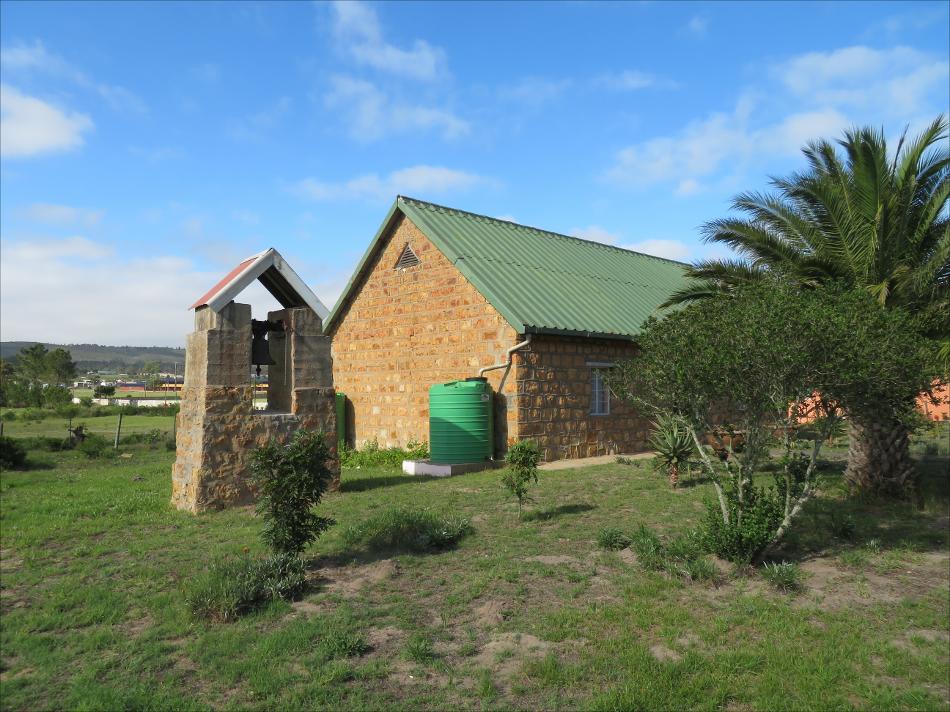Hessequa, Albertinia, Lutheran Church

View/
Author
C. F. Voss & Sohn
Baumgart
Date Created
18691879
Format Extent
19 colour photographs1 spreadsheet
Rights
These items are subject to copyright protection. Reproduction of the content, or any part of it, other than for research, academic or non-commercial use is prohibited without prior consent from the copyright holder.Stellenbosch University
Metadata
Show full item recordAbstract
Albertinia, Lutheran Church. The Lutheran Church of Albertinia was originally an outstation of the Riversdale mission of the Berlin Missionary Society. That mission was established in 1868 and became the most important one in the Eden region. After the inauguration of the church in Riversdale followed soon a large bell that was a gift of the Pyritzer Missionsfreunde. It is that bell that ended up in Albertinia, probably around 1908 when Riversdale got the Korfhage bell. The bell hangs in a nice stone construction to the side of the church that is also built with similar stones. Having a closer look at the bell shows a beautiful bell that is rather well preserved. The canon consists of 6 carefully carved angel heads. Below the crown is a broad decorated band. Below it a moulding ring and a band of drops pointing downwards. On a visible waist one reads, Gegossen von C.Voss
in Stettin 1869
No. 409. On the reverse waist stands an important text that illustrates the dedication of the bell and its origin.
Kommt, den es ist Alles bereit,
Luc. 14, 17. Der Pyritzer Missions.Verein der
Missions.Gemeinde zu Riversdale. Above the sound bow are four moulding wires, the top two close together. On the lip one finds a decorative freeze made up of leaf like figures, pointing upwards. From the above we can conclude that the bell has been made in the foundry of Carl Voss from Stettin, formerly a city in Germany but now in Poland with the name Szczecin. There are six other bells from the same foundry in South Africa, namely at Heidelberg, Ladismith, Mossel Bay, Herbertsdale, Amalienstein and Kerkplaas. It seems indicative that the Voss-foundry had good relations with the Berlin Missionary Society in South Africa. The church in Albertinia however held another surprise. Under the seats in the rear of the church sits a bell of historical value. Immediately below the shoulder is a small freeze, filled with half circles surrounding a leaf. Then follow two moulding rings with in between a reference to the foundry. It reads Gust: Baumgart Berlin. Below this sentence stands a second decorating freeze. This time it shows a sequence of heart shaped figures. In the middle of the waist are five moulding wires. On one side stands in between the third and fifth wires Aasvogelberg 1879. On the reversed side but at the same height stands Komt, Want Alle Dingen Zijn Gereed.
Lucas 14 .Vers 17. Above the sound bow are again three moulding wires with the middle one substantially thicker than the two surrounding ones. This is a most remarkable bell. The BMS had served a number of outstations from its mission in Riversdale that was established in 1868. One of them was at Aasvogelberg that was served from 1872 and onwards. Already in 1879 the outstation got its own church and the bell was definitely meant to serve there. According to information from the local caretaker, the bell was removed from Aasvogelberg since it was cracked. We indeed could discover a small crack on the lip of the bell. It was then stored in the church in Albertinia. Apart from this (almost invisible) crack, the bell is in excellent condition and shows no sign of wear or tear. The foundry Baumgart that figures on the bell is not contained in the comprehensive list of bronze foundries within Germany. Also, the abbreviation GUST suggests that the bell comes from a steel factory, but up to now this hypothesis could not be checked. In any case, if the bell is made of steel, it has been remarkably well preserved.
Collections
- Hessequa [15]
